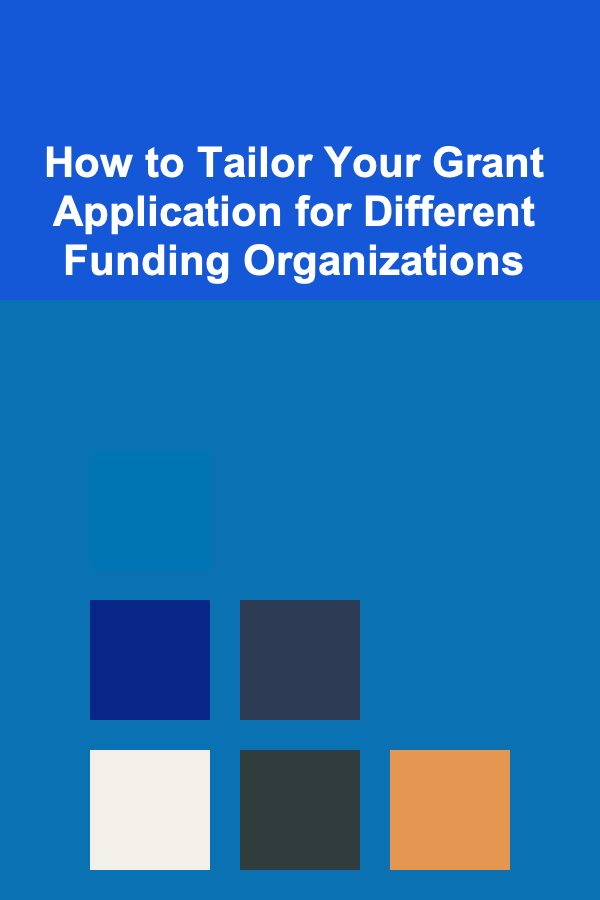
How to Tailor Your Grant Application for Different Funding Organizations
ebook include PDF & Audio bundle (Micro Guide)
$12.99$6.99
Limited Time Offer! Order within the next:

When applying for grants, one size does not fit all. Different funding organizations have their own set of priorities, guidelines, and goals. To maximize your chances of receiving funding, it's crucial to tailor your grant application to meet the specific requirements of each organization. A well-tailored application demonstrates that you understand the organization's mission, priorities, and the type of projects they are likely to fund. In this guide, we'll explore actionable steps to help you craft customized grant applications that align with different funding organizations.
Understand the Funding Organization
Before you even start writing your grant application, take the time to deeply understand the funding organization you are applying to. Each organization has its unique focus areas, funding priorities, and strategic goals. You need to know these in order to align your proposal accordingly.
Research the Organization's Mission and Vision
Start by researching the funding organization's mission, vision, and goals. These are typically outlined on their website or in their annual reports. Ask yourself the following questions:
- What is their overarching mission? This will help you determine if your project aligns with their values.
- What are their key focus areas? Some organizations may focus on specific sectors like education, healthcare, the arts, or the environment. Understanding this will help you decide if your project fits into their priorities.
- Who do they typically fund? Identify the types of organizations or individuals they tend to fund. Some organizations may focus on supporting nonprofits, while others might fund academic research or community-driven projects.
The more you know about the organization's goals and funding history, the better equipped you'll be to align your proposal with their interests.
Examine Their Grant Guidelines
Each funding organization will provide specific guidelines for applicants. These guidelines are critical because they outline the expectations for your application, including required documents, formatting instructions, eligibility criteria, and deadlines. Ensure you carefully read and follow these guidelines, as failure to do so can result in your proposal being disqualified.
Understand Their Funding Priorities
Many funding organizations prioritize certain types of projects over others. For example:
- Mission-driven grants: Some organizations fund projects that align directly with their stated mission or focus areas.
- Geographic focus: Certain funders may prioritize specific regions or communities, whether local, national, or international.
- Innovation vs. Tradition: Some organizations might focus on funding innovative or cutting-edge projects, while others might prefer traditional, proven models.
To tailor your application effectively, be clear on what the organization values most, and position your project in a way that highlights those aspects.
Customize Your Proposal Based on the Funders' Preferences
Once you've gathered all the necessary information about the organization, it's time to tailor your proposal. Here are key areas to focus on to ensure that your application resonates with the specific funding organization.
1. Align Your Project Goals with the Organization's Mission
Your project should clearly align with the funding organization's mission and goals. Use the mission statement and focus areas to guide your proposal and ensure that your project addresses a need or challenge they are interested in solving. Highlight how your project directly supports their strategic priorities.
- Focus on shared objectives: If the organization prioritizes community development, for example, emphasize how your project will benefit local communities.
- Use their language: Many funding organizations use specific terminology in their mission statements. Try to incorporate their language into your proposal to demonstrate a clear alignment with their goals.
2. Showcase the Impact and Outcomes
Funding organizations are typically interested in the impact of the projects they fund. Tailor your application to demonstrate how your project will create measurable, long-term impact. Be specific about the outcomes your project will achieve and how they align with the organization's objectives.
- Use data: Many funding organizations like to see data and evidence that your project will deliver the desired results. For example, if you're working on an educational program, include statistics about the current educational gap and how your project will bridge it.
- Provide clear metrics: Define what success looks like for your project. For example, how many people will benefit, what behaviors will change, or how you will measure success.
3. Address the Organization's Criteria
Funders will often have specific criteria that must be addressed in your application. These may include:
- Innovation: If the funder prioritizes innovation, make sure to highlight what is new or unique about your project. Demonstrate how your approach differs from other projects or solves a problem in a novel way.
- Sustainability: Many organizations look for projects that have a lasting impact. Show how your project will continue to deliver benefits even after the funding period ends.
- Collaboration: Some funders prioritize collaborative projects. If your project involves partnerships, showcase these collaborations and how they will enhance the success of the initiative.
4. Tailor Your Budget
Funding organizations often have strict requirements when it comes to budgets. Some funders may have a cap on how much they are willing to contribute to a specific project or may only fund certain types of expenses (e.g., direct program costs vs. administrative overhead). Ensure your budget aligns with the funding organization's preferences.
- Follow their guidelines: Some funders will specify how they want budgets to be presented (e.g., in a particular format or categorization). Be sure to follow these instructions closely.
- Justify each expense: Provide a clear explanation for each budget item. Show that the funds will be used efficiently and in a way that directly contributes to the project's success.
5. Highlight Your Organization's Capacity
Funders want to know that you have the capacity to manage and execute the project effectively. This includes having the right team, resources, and systems in place.
- Team expertise: If the funder values certain expertise, such as a background in data analysis or community engagement, make sure to highlight the qualifications and experience of your team members.
- Previous successes: If your organization has successfully implemented similar projects, share evidence of this. This can include past project outcomes, partnerships, and testimonials.
- Operational capacity: Demonstrate that your organization has the infrastructure, staff, and systems in place to handle the project. Highlight any past experiences in managing large-scale projects, particularly those funded by grants.
Craft Your Narrative to Speak to the Funder's Values
One of the most effective ways to tailor your grant application is to craft a compelling narrative that speaks directly to the funding organization's values and priorities. Your narrative should emphasize how your project fits into their larger vision for societal change or impact.
Use a Storytelling Approach
Rather than presenting a list of facts and figures, consider using storytelling techniques to engage the reader. Start by introducing the problem you are addressing, the community or group it affects, and the innovative solution your project offers.
- Introduce the problem: Describe the specific problem your project will solve. Use emotional appeal where appropriate to show the human side of the issue.
- Present the solution: Show how your project is a viable and innovative solution. Demonstrate how it directly addresses the problem and how it will lead to measurable improvements.
- Highlight the impact: Illustrate how the funding organization's investment will make a meaningful difference in the community or sector you are serving.
Use Language and Tone that Resonates with the Funder
Each funding organization may have a preferred tone or style for grant proposals. Some may prefer a formal and technical tone, while others may appreciate a more conversational approach. Look at their past grant recipients and the types of projects they have funded to gauge the tone that works best. Match your writing style to this tone.
Proofread and Revise
Finally, once your grant application is tailored to the funding organization, take the time to carefully proofread and revise it. A well-written and polished application reflects your professionalism and attention to detail.
- Get feedback: Before submitting, have colleagues or mentors review your application. They may catch errors you missed or provide suggestions to improve your submission.
- Follow formatting rules: Adhere to any formatting guidelines provided by the funder, including font size, margins, and page limits.
Conclusion
Tailoring your grant application to different funding organizations is an essential part of the process. By understanding the organization's mission, priorities, and funding criteria, and aligning your proposal accordingly, you can increase your chances of success. A well-tailored application demonstrates your commitment to the project and your ability to meet the funder's goals. With careful research, a clear narrative, and attention to detail, you can craft compelling applications that stand out and meet the specific needs of each funding organization.

How to Soundproof Your Home to Prevent Hearing Loss
Read More
How to Track Your Gardening Goals and Achievements
Read More
Mastering the Art of Branding: A Consultant's Guide to Transformative Business Growth
Read More
Mechanical Designer's Handbook: Advanced Techniques for Optimizing Designs and Systems
Read More
How to Build AI for Human-Computer Interaction
Read More
Hummingbird Observation: A Deep Dive into the Miniature Marvels
Read MoreOther Products

How to Soundproof Your Home to Prevent Hearing Loss
Read More
How to Track Your Gardening Goals and Achievements
Read More
Mastering the Art of Branding: A Consultant's Guide to Transformative Business Growth
Read More
Mechanical Designer's Handbook: Advanced Techniques for Optimizing Designs and Systems
Read More
How to Build AI for Human-Computer Interaction
Read More